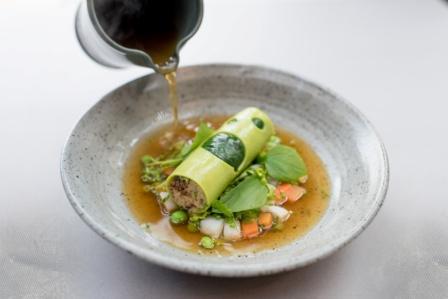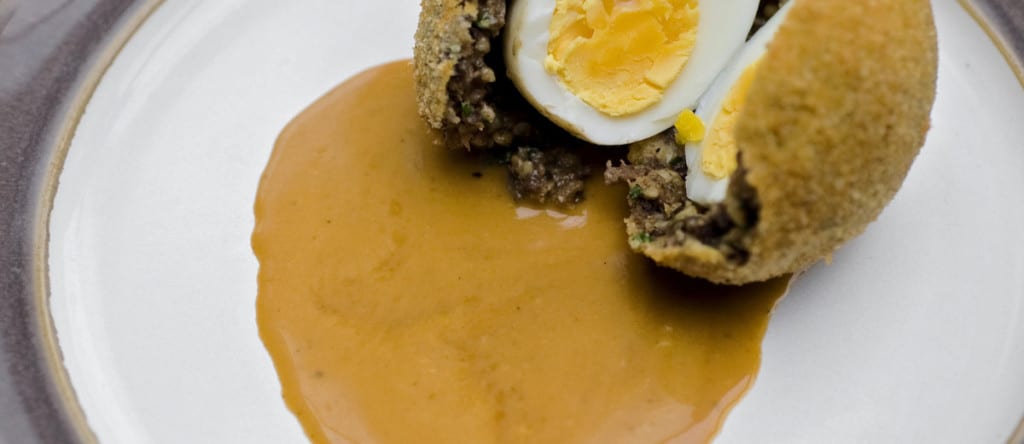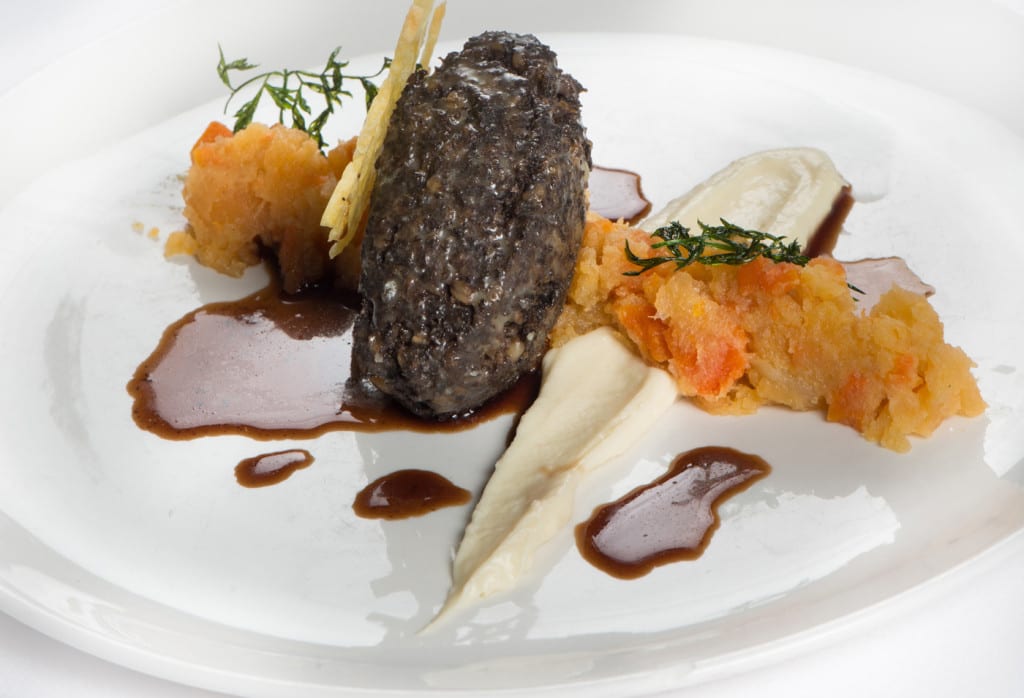Serves: 4
Time to cook: 60 mins

Picture: Tom Kitchin
"The cannelloni is a bit challenging, but it’s such a flavoursome dish and looks just wonderful on the plate. We’ve had it on the lunch menu at our restaurant, The Kitchin, and it’s proved to be one of our most popular choices."
Ingredients
For the lamb stock (makes 1 litre)
• 2.5kg lamb bones, chopped
• 2 tbsp olive oil
• 5 carrots, chopped
• 1 onion chopped
• 1 fennel bulb, chopped
• 1 handful of thyme
• 1 head of garlic, cut in half
• ½ red pepper, chopped
• 1 tsp ground cumin
• 100ml tomato purée
• 100ml white wine
For the haggis cannelloni
• 200g fresh pasta
• 400g haggis – cooked and rolled into 100g cylinders
• 4 blanched spinach leaves
• 80g diced carrots – blanched in boiling salted water
• 80g diced turnip – blanched in boiling salted water
• 80g peas – blanched in boiling salted water
• 80g broad beans – blanched in boiling salted water
Method:
To make the lamb stock
Preheat the oven to 200C/Gas
Mark 6. Put the lamb bones in a roasting tray with half the oil. Roast for 20-25 minutes until golden brown.
Add the rest of the oil to a heavy-bottomed pan and sweat the carrots, onion, fennel, thyme and garlic on top of the stove for a good 8-10 minutes. Add the red pepper and the cumin and cook for another 3-4 minutes. Add the tomato purée and cook for a further 2-3 minutes.
Pour the white wine into the pan and add the roasted lamb bones. Cover with about 2 litres of water, bring to the boil and skim. Cook for 3-4 minutes, then pass through a fine sieve. Pour the stock back into the pan and boil until reduced by half.
For the haggis cannelloni
Roll out the pasta, taking it to number 2 through the machine. Cut it into 3in x 2in rectangles. Blanch the pasta in boiling salted water for 40 seconds, then refresh in iced water.
Rub the pasta sheets carefully with oil. If you want, here you can cut holes into the pasta so you get the different colours coming through in the presentation.
Place each rectangle of pasta on to oiled cling film. Place the blanched spinach leaf on top.
Then put 100g of haggis on top of each and roll it in cling film carefully. Steam for 4-5 minutes – meanwhile, blanch your vegetables.
Place the blanched vegetables on the bottom of your serving bowl. Remove the haggis cannelloni from the steamer, then carefully cut each end of the cling film and remove the cannelloni.
Place the cannelloni on the bed of vegetables, and pour the stock over the top. The hot stock will ensure the dish is warm enough to serve.
Serves: 4
Time to cook: 20 mins

"The sweet creaminess of the locally produced Glenkinchie whisky is a perfect match for the spicy, crunchy haggis and the tangy mustard mayonnaise. Wonderful with a glass of beer or a dram of your choosing."
Ingredients
• 5 tbsp pasteurised mayonnaise
• 2 tsp Arran mustard
• 30ml Glenkinchie whisky
• 360g finest quality haggis
• 100g seasoned flour
• 3 free-range eggs, beaten
• 200g pinhead oatmeal
• vegetable oil
• salt and pepper
Method:
1. Mix the mayonnaise, mustard and whisky in a bowl and place in the fridge until needed.
2. Roll the haggis into 24 individual balls (approximately 15g each).
3. Arrange the flour, beaten eggs and pinhead oatmeal into three separate bowls.
4. Dip each haggis ball into the flour then the beaten egg and finally into the oatmeal and put to one side.
5. Carefully heat the vegetable oil in a deep fat fryer or a deep pan until it reaches 170C.
6. Place the individual haggis balls into the hot oil to deep fry for four minutes then drain on kitchen paper and season lightly with salt and pepper.
7. Serve straight away with a generous helping of the mustard and whisky mayonnaise.
Serves: 2
Time to cook: 50 mins

"This is one of my favourite Indian inspired dishes with a Scottish twist, and one of many!
"The subtle flavours of the aubergine compliment the strong spiciness of the haggis; together with the garlic, tomato and lemon dressing the combination makes for a delicious, surprisingly light dish."
• 3 decent sized aubergines
• 250g haggis
• three deseeded and chopped plum tomatoes
• a medium red onion or banana shallot
• a garlic clove
• 4 tbsp olive oil (this is really just a guideline)
• plenty of salt and fresh black pepper
• a big handful of chopped coriander
• the juice of a lemon or two, again to taste
1. Take the haggis out of its skin and pop into some tinfoil with a good knob of butter. Wrap it up and place into a preheated 180C oven. The haggis is already cooked so you only need to reheat.
2. After ten minutes open the foil package and mash up the haggis. Now cook uncovered for a further 15 minutes.
3. Meanwhile put the aubergines on the naked flame of a gas hob or directly on the electric hob, turned up to full. Let fire take its natural course. The skins will start blistering and blackening.
Turn the aubergines to ensure an even cooking. The heat is actually cooking the inside. Be bold. Black is good. They occasionally pop so be careful.
4. As soon as they are burned and looking rather defeated put them into a bowl and cover with clingfilm or foil.
You need to keep the heat in; the heat from the hot aubergines loosens the skins. Leave to one side for 30 minutes.
5. Meanwhile chop the tomatoes and the onion, crush the garlic. Mix these with the oil and lemon juice. This is effectively the dressing.
6. When the aubergines have cooled remove the skins. They may still be hot on the inside so take care. The odd bit of black skin is fine so don’t stress. Try not to take any flesh off with the skin.
There will be a dark liquid residue in the bowl. This is gold. This is smoke. This is flavour. Mash up the aubergine flesh and add the black liquor and dressing.
7. Season; bearing in mind aubergines love salt. Add the cooked haggis and mix well. Finish with the herbs. Smoking….
Serves: 4
Time to cook: 15 mins

"The infamous Scotch egg is often given a bad name, as too many people have been put off by ready-made versions.Actually, made fresh, it can be truly delicious - great posh picnic food or a perfect party snack.
"If you're making them yourself, it's best to eat them warm as soon as you've cooked them, when the egg yolk is still runny. For a true, rustic taste of Scotland, I add haggis to my version in place of pork.
"Haggis was once considered a poor man's dish made from leftovers and, while it certainly follows my principles of using absolutely every part of produce in cooking, it has also become a regular feature on many tables across the country. If you're too afraid to make your own haggis, make sure you buy a quality, spicy haggis from your local butcher.
"It's easier than you think to make your own Scotch eggs and so much more satisfying. It's a great way to use up eggs if you have them in your fridge and makes a nice change from standard poached, fried or scrambled. I like to serve this as a Sunday snack."
• 5 hard boiled eggs, with the shells removed
• 500g haggis, cooked
• 1 large raw egg
• 3oz approx of dry bread crumbs
• small quantity of flour
• pinch of mace, salt, freshly ground pepper
First off, dust the hard boiled eggs in a little seasoned flour. Wrap/mould the haggis meat round the egg, making sure there are no gaps.
Then beat the egg and coat the meat-covered egg with this and then bread crumbs.
Deep fry in hot oil 185C, taking care as you put the eggs into the oil. Cook for about five or six minutes.
If you don’t have a deep fat fryer, they can be cooked in oil in a frying pan, turning frequently to ensure the meat is fully cooked.
Drain and serve hot.
Serves: 4
Time to cook: 80 mins

• 1 x 450gm \ 1lb haggis
For the Swede and Saffron:
• 250g Peeled and diced swede
• 25g Butter
• A pinch of saffron
• Salt
• Cracked pepper
For the Potatoes:
• 250g Potatoes (floury), peeled and cut to an even size
• 150ml Milk
• 50ml Double cream
• 25g Butter
• Sea salt
• White pepper
• Nutmeg
For the Whisky Sauce:
• 10g Unsalted diced butter
• 1 Shallot peeled and finely diced
• 1 Small sprig of thyme
• 1 Clove of garlic
• 50ml of whisky
• 100ml Veal stock or beef stock (reduced)
• 100ml Double cream
• Small bunch of chives
For the haggis
1.Heat the haggis, by wrapping, in the packaging, in foil and submerging into a pan of boiling water, simmer until piping hot (this will take about an hour).
2. When hot remove packaging and soften the haggis so it can be spooned -you may wish to add a splash of whisky.
Alternatively follow the heating instructions on the pack but do ensure that it is piping hot.
For the swede
3. In a pot, place the swede in salted water, bring to the boil, add the saffron and cook until just cooked, drain into a colander.
4. Place the pan back on the heat, add the butter, allow to froth, add the swede back in and sauté until cooked and breaking up, pass through with a masher a few times. Taste and season with salt and pepper, then keep hot until required.
For the potatoes
5. Place the potatoes in cold water, season with salt, bring to the boil and cook through. Once cooked, pass through a sieve.
6. Bring the butter, cream and 2\3 of the milk to the boil and add back in with the potatoes, beating well, adjust consistency with more milk if too thick.
7. Season with salt, pepper and nutmeg – keep hot.
To make the sauce
8. Place a small pan on the heat, add the butter, then add the shallots and sweat until clear.
9. Add the garlic clove and thyme sprigs and sauté for a further minute.
10. Deglaze the pan with the whisky and allow to flambé to burn off alcohol, then reduce by 2\3.
11. Add the reduced stock to the pan and reduce by a half.
12. Add the double cream into the stock, bring back to the boil, check consistency and adjust as required, strain before using, keep hot.
To serve
13. Take a large spoon of the runny potatoes and drag down the centre of the plate.
14. Make a line of swede across the bottom of the potatoes.
15. Add a quenelle of the haggis to the centre of the plate. Pour the sauce over the haggis and around the plate. Garnish as required with snipped chives, edible flowers and crisp potatoes.
16. Enjoy wi a wee drappie o the cratur!
Serves: 2
Time to cook: 20 mins

• 2 x egg yolks (reserve the whites for making the soufflé)
• 450ml milk
• 125g caster sugar
• 5g corn flour
• 55g plain flour
• 75g Talisker whisky
• 10g honey
• Soft butter
• Porcelain ramekins
• Pastry brush
• 500g raspberries
• 1 lemon
• 280g sugar
• 100g water
For the Soufflé base
1.Place all the ingredients into a bowl and mix together with a whisk, place the contents into a saucepan and cook out over a low heat whisking until the mixture boils.
2. Transfer to a suitable container.
For the Raspberry Sorbet
3. Bring water and sugar to the boil, place raspberries into a food processor, add lemon juice and sugar syrup and blend – pass through a fine sieve to remove pips.
4. Transfer to an ice cream maker.
For the Soufflé
5. Butter the ramekins using the soft butter, brush the butter in an upward motion covering the ramekin completely, and then add caster sugar so it coats the ramekins.
To make the Soufflé
6. Place the egg whites into a bowl, whisk the whites whilst slowly adding the caster sugar until it forms firm peaks.
7. Fold the whites into the Cranachan base mixture gently so as not to remove the air from the egg whites.
8. Spoon into the ramekins and smooth over with a palate knife. Gently with your thumb go around the inside of the ramekin to a 1cm depth. Sprinkle with oats.
9. Cook in a pre-heated oven at 190o C for 6 minutes or until risen.
To Serve
10. Remove soufflé from oven and serve with a scoop of raspberry sorbet.
Like this? See also: